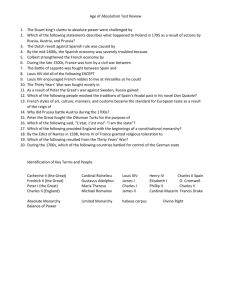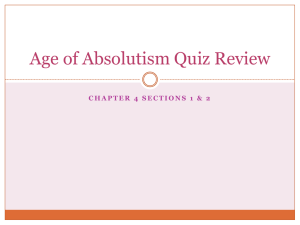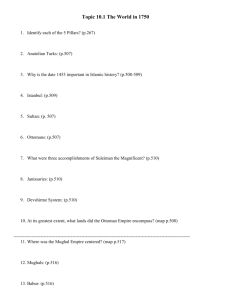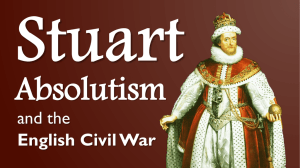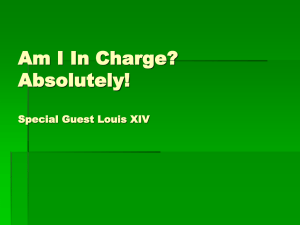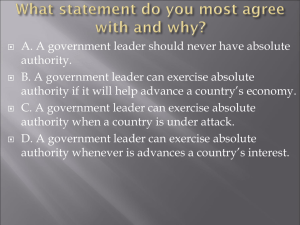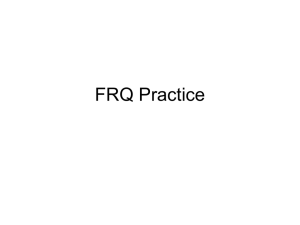France and the Construction of the Absolute Monarchy Notes
advertisement
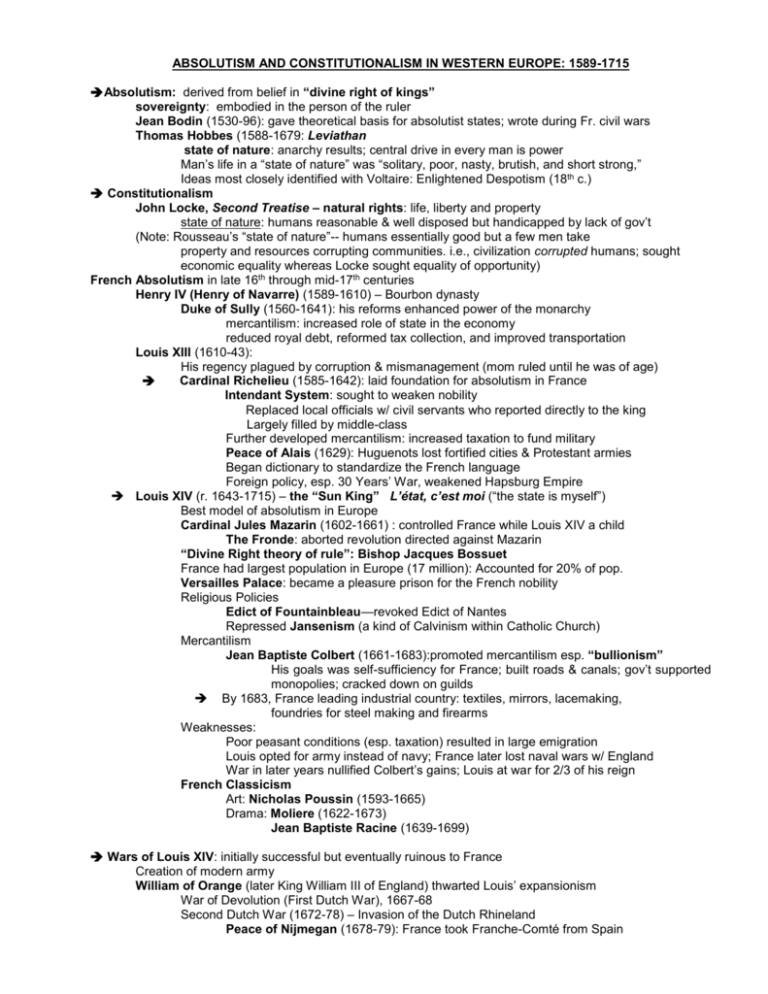
ABSOLUTISM AND CONSTITUTIONALISM IN WESTERN EUROPE: 1589-1715 Absolutism: derived from belief in “divine right of kings” sovereignty: embodied in the person of the ruler Jean Bodin (1530-96): gave theoretical basis for absolutist states; wrote during Fr. civil wars Thomas Hobbes (1588-1679: Leviathan state of nature: anarchy results; central drive in every man is power Man’s life in a “state of nature” was “solitary, poor, nasty, brutish, and short strong,” Ideas most closely identified with Voltaire: Enlightened Despotism (18th c.) Constitutionalism John Locke, Second Treatise – natural rights: life, liberty and property state of nature: humans reasonable & well disposed but handicapped by lack of gov’t (Note: Rousseau’s “state of nature”-- humans essentially good but a few men take property and resources corrupting communities. i.e., civilization corrupted humans; sought economic equality whereas Locke sought equality of opportunity) French Absolutism in late 16th through mid-17th centuries Henry IV (Henry of Navarre) (1589-1610) – Bourbon dynasty Duke of Sully (1560-1641): his reforms enhanced power of the monarchy mercantilism: increased role of state in the economy reduced royal debt, reformed tax collection, and improved transportation Louis XIII (1610-43): His regency plagued by corruption & mismanagement (mom ruled until he was of age) Cardinal Richelieu (1585-1642): laid foundation for absolutism in France Intendant System: sought to weaken nobility Replaced local officials w/ civil servants who reported directly to the king Largely filled by middle-class Further developed mercantilism: increased taxation to fund military Peace of Alais (1629): Huguenots lost fortified cities & Protestant armies Began dictionary to standardize the French language Foreign policy, esp. 30 Years’ War, weakened Hapsburg Empire Louis XIV (r. 1643-1715) – the “Sun King” L’état, c’est moi (“the state is myself”) Best model of absolutism in Europe Cardinal Jules Mazarin (1602-1661) : controlled France while Louis XIV a child The Fronde: aborted revolution directed against Mazarin “Divine Right theory of rule”: Bishop Jacques Bossuet France had largest population in Europe (17 million): Accounted for 20% of pop. Versailles Palace: became a pleasure prison for the French nobility Religious Policies Edict of Fountainbleau—revoked Edict of Nantes Repressed Jansenism (a kind of Calvinism within Catholic Church) Mercantilism Jean Baptiste Colbert (1661-1683):promoted mercantilism esp. “bullionism” His goals was self-sufficiency for France; built roads & canals; gov’t supported monopolies; cracked down on guilds By 1683, France leading industrial country: textiles, mirrors, lacemaking, foundries for steel making and firearms Weaknesses: Poor peasant conditions (esp. taxation) resulted in large emigration Louis opted for army instead of navy; France later lost naval wars w/ England War in later years nullified Colbert’s gains; Louis at war for 2/3 of his reign French Classicism Art: Nicholas Poussin (1593-1665) Drama: Moliere (1622-1673) Jean Baptiste Racine (1639-1699) Wars of Louis XIV: initially successful but eventually ruinous to France Creation of modern army William of Orange (later King William III of England) thwarted Louis’ expansionism War of Devolution (First Dutch War), 1667-68 Second Dutch War (1672-78) – Invasion of the Dutch Rhineland Peace of Nijmegan (1678-79): France took Franche-Comté from Spain League of Augsburg (formed in 1686): HRE, Spain, Sweden, Bavaria, Saxony, Dutch Rep. War of the League of Augsburg (1688-97) – ( King William’s War): ended in status quo William of Orange (now king of England) brought England in against France. War of Spanish Succession (1701-13) – (Queen Anne’s War) will of Charles II (Hapsburg king): all Spanish territories to grandson of Louis XIV Grand Alliance: England, Dutch Rep., HRE, Brandenburg, Portugal, Savoy Battle of Blenheim (1704) Treaty of Utrecht (1713): Britain was biggest winner: gained asiento from Spain, Gibraltar and Minorca. partitioned Spanish possessions: Belgium given to Austria Louis’ grandson enthroned, prevented unification of Bourbon dynasties. Kings recognized in Sardinia (Savoy) and Prussia (Brandenburg) Costs of Louis XIV’s wars: destroyed French economy, depopulation, weakened Louis XIV. Decline of the Spanish Empire (although it remained most powerful military until mid-17th c.) Spanish Armada, 1588 loss of middle class: Moriscos and Marranos (+ Moors and Jews a century earlier) inflation taxation large number of privileged people who hated work religion overshadowed politics defeat in 30 Years’ War: politically and economically disastrous 1640, Portugal reestablished independence. Treaty of the Pyranees (1659): marked end of Spain as a Great Power loss of parts of Spanish Netherlands and territory in northern Spain to France Population in 1660 had declined to 5.5 million from 7.5 million in 1550 Charles II (1665-1700): one of worst rulers in Hapsburg history No heir to throne resulted in War of Spanish Succession Spain lost most possessions at Treaty of Utrecht (1713) Decline of Spain exemplified in Don Quixote by Miguel Cervantes (1605) Constitutionalism in England James I: belief in “divine right of kings” King of Scotland; son of Mary “Queen of Scots” Leadership of Church went to those with Arminian beliefs (predestination but with “good works”) Archbishop Laud tried to impose Catholic-style ritual; Puritans dismayed King claimed “no bishop, no king” to Puritan demand to end bishop control. Monarchy plagued by lack of revenue (expensive was of Elizabeth drained treasury) Charles I (1625-1649): sought to rule without Parliament and to control the Anglican Church Petition of Right, 1628: Parliament attempt to bribe king (taxes) in return for accepting Parliament’s right to tax, habeas corpus, no quartering, and no martial law in peacetime Charles dissolved Parliament in 1629; did not reconvene until 1640 Religious persecution most important reason for civil war: led by Archbishop Laud Long Parliament – summoned in 1640 (after failure of 2-month “Short Parliament”) In return for granting taxation, Parliament made demands: certain high leaders be tried: (Laud eventually executed) Star Chamber abolished Parliament could not be dissolved w/o its consent The English Civil War (Puritan Revolution; Great Rebellion) – 1642-1649 Cavaliers: supported the king Roundheads, Puritans opposed king; Oliver Cromwell led “New Model Army” major issues of the war Battle of Nasby: Final major battle of war; Scottish Army assisted Cromwell Division resulted between Presbyterians in Parliament (majority) and soldiers who were independent and sought congregationalism New Sects: Levellers: Radical religious revolutionaries; sought social and political reform. Quakers: believed in “inner light”; rejected church authority; pacifists “Rump Parliament”: Pride’s Purge removed all non-Puritans and Presbyterians from Parliament Charles I beheaded in 1649 Interregnum: 1649-1660 rule without king The Commonwealth (1649-1653): a republic – abolished monarch and House of Lords The Protectorate (1653-1659), Oliver Cromwell Lord Protector (Dictatorship) The Restoration (1660-1688) Parliament in 1660 reelected according to old franchise: Anglicans back in power Charles II “The Merry Monarch” (1660-1685): Stuarts restored to the throne Declaration of Breda: Charles agreed to abide by Parliament’s demands The Clarendon Code, 1661: Anglicans excluded Dissenters (Puritans) from politics Declaration of Indulgence, 1673: Charles II granted free worship to Catholics Test Act of 1673: all officeholders must take communion in Anglican Church Was Anglican response to Declaration of Indulgence Habeas Corpus Act (1679): no arbitrary arrest and speedy trial Parliament was split and fragmented into two political parties Tories: king’s supporters, nobles Whigs: middle-class and merchants; also high aristocracy Scotland gained its independence in 1660 as result of Restoration Charles attempted to impose Anglicanism in Scotland; war resulted James II (1685-1688): sought to Catholicize England; forced to abdicate Glorious Revolution (1688) William III (William of Orange) and Mary: Protestantism secured in England Act of Toleration: granted religious freedom (except to Catholics, Jews, and Unitarians Bill of Rights (1689): constitutional monarchy British Constitution: consisted of habeas corpus act, petition of right, and bill of rights John Locke: Two Treatises on Government: philosophical argument for supremacy of Parliament Act of Settlement (1701): only Anglican could succeed to the throne War of the League of Augsburg (1688-97) – (King William’s War) – (see wars of Louis XIV) Queen Anne (1702-1714): Act of Union (1707) – English and Scottish Parliaments merged = Great Britain Royal veto used for last time Cabinet System of preparing laws for Parliament developed during early 18th century Hanoverian Kings: George I, George II, George III Prime minister became leader of cabinet and responsible to majority party in the House of Commons. Robert Walpole (1721-1742) became first prime minister Weaknesses of British democracy (c. 1800) Limited suffrage unfair representation (“rotton boroughs”) open voting religious-property requirements for office hereditary House of Lords United Provinces of the Netherlands: 17th century = “Golden Age of the Netherlands” Confederation of 7 provinces: each province autonomous with its leader--stadtholder wealthiest and most civilized country in Europe Calvinism and Arminianism Amsterdam became center of commerce (replacing Antwerp) Impact of War of Spanish Succession (Treaty of Utrecht) Sweden: Gustavus Adolphus (1611-32) reorganized gov’t; nobles dominated army & bureaucracy ABSOLUTISM IN EASTERN EUROPE Three aging empires: gave way to new empires of Austria Prussia and Russia Holy Roman Empire: religious divisions and war in 16th and 17th century Ottoman Empire: could not maintain possessions in E. Europe and Balkans Poland: liberum veto – voting in Polish parliament had to be unanimous (= weak gov’t) serfdom: beginning in 16th century and continuing into 18th century, mass of peasantry became serfs robot: peasants owed lord 3 to 4 days a week of forced labor Austrian Empire Multinational empire: Austrian, Hungarian, & Bohemian kingdoms Cosmopolitan aristocracy: serfdom Leopold I (1658-1705),: successfully repelled Turks Turkish threat: relatively religiously tolerant empire Suleiman the Magnificent (d. 1566): nearly conquered Austria in 1529, captured Belgrade (Serbia), nearly 1/2 of Eastern Europe including all Balkan territories, most of Hungary, and part of southern Russia. “Janissary corps”: former Christian children dedicated fully to the military siege of Vienna, 1683: last attempt by Turks to take Central Europe Pragmatic Sanction (1713) issued by Charles VI: Habsburg territories indivisible; only Habsburgs could rule Prussia: House of Hohenzollern Frederick William – The “Great Elector”(1640-1688) Brandenburg-Prussia rule consolidated after 30 Years’ War: military force & taxation Junkers: nobility sided with king for stability; hereditary serfdom in 1653 Created most efficient army in Europe Frederick I (Elector Frederick III) “The Ostentatious” (1688-1713); 1st “King of Prussia” Allied with Habsburgs in War of League of Augsburg and War of Spanish Succession Frederick William I (1713-1740) “The Soldiers’ King” Established Prussian abolutism “Sparta of the North”: Largely a military state – best army in Europe Junkers became officers caste in army in return for king’s absolutism Russia Slavic and Viking ancestry: 1st millenium AD Boyars: Russian nobles Mongols – “Golden Horde” took control in 13th c: left legacy of ruthless rule Ivan III “Ivan the Great” (1442-1505) “Third Rome”: Assumed leadership of Orthodox Christian Church; Ivan IV “Ivan the Terrible” (1533-1584), first to take title “tsar” Married a Romanov Defeated last of Mongels: conquered Baltic, Far East, and Black Sea region Began westernizing Peasants fled oppressive rule: became “Cossacks”; led to more severe serfdom “Time of Troubles”, 1584: period of chaos after Ivan’s death Romanov Dynasty (1613-1917) Michael Romanov (1613-1645) Created Russian empire across Asia to the Pacific (largest nation by 1689) “Old Believers” (The Raskolniki): resisted westernization, severely persecuted. Peter the Great (1682-1725) 1698, put down revolt by strelski (Moscow Guards) westernization (modernization): mostly for military purposes state-regulated monopolies created; industrial serfdom Table of Ranks: educational training for new civil service (mostly of nobles) St. Petersburg begun in 1703 on Baltic; largest city in Northern Europe by his death. “Winter Palace” sought to emulate Versailles. Great Northern War (1700-1721) Charles XII, 18-yr-old Swedish king Battle of Poltava, 1709: Peter defeated Sweden Treaty of Nystad (1721): Peter gained Baltic states “window to the West” Catharine II, “Catharine the Great” (1762-96) – (see Enlightened Despotism) THE BAROQUE: The “Age of Bernini” characteristics: emphasis on grandeur, spaciousness, unity, and emotional impact Gianlorenzo Bernini (1598-1650): sculptor, architect, painter; Colonnade for piazza in front of St. Peter’s Basilica Versailles Palace: Marquis Louvois (architecture); Louis LeVau (1612-70) -- gardens Schonbrunn Palace in Vienna: Leopold I’s response to Versailles Art Peter Paul Rubens (1577-1640) Rembrandt Van Rijn (1606-1669) – greatest painter of the era Nicolas Poussin (1595-1665) – French Classicism El Greco: Mannerism (1541-1614) --Emphasized dramatic and emotional qualities Music Monteverdi (1547-1643) Orfeo (1607)—first opera Antonio Vivaldi (1678-1741) Johann Sebastian Bach (16?-1750) George Frideric Handel (1685-1759) Rococo (in France) Characteristics: elegance, pleasantness, frivolity; contrasts emotional grandeur of Baroque influenced Haydn and Mozart during the classical period in music (1770-1800) SCIENTIFIC REVOLUTION Regiomontanus and Nicholas of Cusa: laid mathematical framework for Copernicus and others Nicolaus Copernicus (1473-1543) heliocentric view (instead of geocentric view) Church officials force Copernicus to retract his views Tycho Brahe (1546-1601) – mass of scientific data from observations used by Kepler & others Johann Kepler (1571-1630) – 3 laws of planetary motion Galileo Galilei (1564-1642) – telescope, proves Copernicus’s heliocentric theory Medicine: Scientists began challenging Greco-Roman medical authority (esp. Galen-2nd c. AD) Vesalius The Structure of the Human Body (1543): renewed and modernized study of anatomy William Harvey (1578-1657): On the Movement of the Heart and Blood (1628)-- blood circulation Francis Bacon (1561-1626) empiricism: “renounce notions and form acquaintance with things” inductive method: conclusion is reached after much observation Rene Descartes (1596-1650) deductive method: conclusion is reached by logic “I think, therefore I am” (cognito ergo sum) Cartesian dualism: divided all existence into the spiritual and the material Sir Isaac Newton (1642-1747): Principia universal gravitation Royal Society founded in 1662 to promote scientific research; other academies founded in Europe Significance of scientific revolution: leads to Enlightenment Agricultural Revolution Improvement in exploration THE ENLIGHTENMENT secular world view: first time in human history; marked end of age of religion natural science and reason deism: God created universe and then stepped back and left it running (like a clock) Grew out of Newton’s theories regarding natural law Thomas Paine, Age of Reason: advocates deism progress: improve society through natural laws Rationalists: advocated perfectibility of society Descartes Baruch Spinoza (1632-77): equated God and nature; impersonal mechanical universe; denied free will Empiricists: emphasized observation as basis for epistemology Francis Bacon – inductive method John Locke (1632-1704) Two Treatises on Civil Government: justified supremacy of Parliament; natural rights Essay Concerning Human Understanding (1690): tabula rasa (“blank slate”) considered one of most important Enlightenment works all human knowledge is the result of sensory experience: thus, human progress is in the hands of society—education! classical liberalism: (see handout) Philosophes: those who made Enlightenment ideas available to a wider audience Edward Gibbon: The Decline and Fall of the Roman Empire – attacked Christianity Bernard de Fontenelle (1657-1757): made scientific revolution accessible to many people Marquis di Beccaria: sought to humanize the criminal law Marquis de Condorcet: human progress would eventually lead to its perfection The Three Great French Philosophes Voltaire (Francois-Marie Arouet) (1694-1778): Candide Baron de Montesqueiu (1689-1755): Spirit of the Laws (1748): checks and balances Jean-Jacques Rousseau (1712-78): Social Contract (1762): general will Denis Diderot (1713-1784) Encyclopedia: greatest and most representative intellectual achievements of the philosophes Economic theory Francois Quesnay (1694-1774) – “physiocrats”: opposed to mercantilist economic theory advocated reform of the agrarian order. Adam Smith (1727-1790): Wealth of Nations (1776): The “Bible” of capitalism; laissez faire Gender theory: women played important role in organizing salons Salons of Madame de Geoffren and Louise de Warens Mary Wollstonecraft Later Enlightenment: Baron Paul d’Holbach (1723-1789): humans were machines governed by outside forces freewill, God, and immortality of soul were foolish myths severe blow to unity of the Enlightenment David Hume (1711-76): emphasized limitations of human reasoning; human mind is nothing but a bundle of impressions; later became dogmatic skeptic that undermined Enlightenment Rousseau believed rationalism and civilization was destroying rather than liberating the individual; emphasized nature, passion—influenced early Romantic movement Immanuel Kant (1724-1794): Separated science and morality into separate branches of knowledge. Science could describe natural phenomena of material world but could not provide a guide for morality Significance of the Enlightenment: leads to Enlightened despotism American and French Revolutions (as a result of classical liberalism) educational reform laissez faire capitalism (in 19th century, esp. U.S.) Theistic opposition to the Enlightenment German pietism: argued need for spiritual conversion and religious experience Methodism: taught need for spiritual regeneration and a moral life that would demonstrate reality of the conversion John Wesley (1703-91): Jonathan Edwards and George Whitefield in America (1st Great Awakening) Jansenism (Catholic sect) in France argued against idea of an uninvolved or impersonal God ENLIGHTENED DESPOTISM – some monarchs adopted certain Enlightenment ideas Overview: In sum, reforms were made but very modest improvements occurred and life of the peasantry remained hard in the 18th century. Progressive reforms included toleration of religious minorities, simplified legal codes, and promotion of practical education. Yet, Absolutists more vigorously sought reforms to strengthen the state and allow them to compete militarily with their neighbors. In essence, continued state building of their predecessors. “Frederick the Great” (Frederick II: 1740-1786) of Prussia At war for first half of his reign War of Austrian Succession (1740-1748) – (King George’s War – 1744-1748) Prussia, France, Bavaria & Spain vs. Austria and Russia Took Silesia from Austria; Prussia now most powerful German state: “Great Power” Treaty of Aix-laChapelle (1748): legitimized Frederick’s conquest. Seven Years War (1756-1763) – (French and Indian War) Prussia alone in fighting France, Russia & Austria (outnumbered 15-1) “Diplomatic Revolution of 1756: Britain allied with Prussia (but of little value) Peter III of Russia let Prussia off the hook at a critical moment Treaty of Paris (1763): Prussia retained Silesia; remained a “Great Power” Became a reformer during 2nd half of his reign – ruler was the “first servant of the state” Religious freedom, education in schools and universities, codified laws, promoted industry and agriculture, encouraged immigration Social structure remained heavily stratified: serfdom; extended privileges for the nobility, Junkers became heart of military; difficult upward mobility for middle class leadership Catherine II of Russia (1762-1798) “Catherine the Great” – 1 of greatest rulers in Euro history Least “enlightened” of the Enlightened Despots westernization: architecture, sculpture, music--supported philosophes reforms: reduced torture, limited religious toleration, some education improvement, increased local control Pugachev Rebellion (1773): largest peasant uprising in Russian history; Catherine gained support from nobility by granting greater control over serfs: high point for nobles--low point for serfs territorial expansion Annexed Polish territory: 3 partitions of Poland in 1772, 1793, and 1795 Gained Ottoman land in the Crimea (controlled by Tartars) Began conquest of Caucasus In 17th century, effectiveness of Russian monarchs limited by vast Russian territories Austria Maria Theresa (1740-1780): Wars of 1740s led to internal consolidation Reduced serfdom (more than any other e. European ruler except her son) Joseph II (1765-1790) – greatest of the Enlightened despots (“greatest good for greatest #”) Abolished serfdom in 1781, freedom of press, freedom of religion & civic rights, more equitable justice system, made German official language (to assimilate minorities), increased control over Catholic education, expanded state schools, left empire in economic and political turmoil: Leopold I rescind many laws (e.g., serfdom) France: rise of aristocratic power and liberalism resulted in end of absolutism Louis XV (1715-1774): Madame de Pompadour: most famous mistress of the 18th c. charmed the king and gained decision-making power Parlement of Paris (partial to nobles) blocked Louis’ absolutist ambitions Renè de Maupeou: dissolved Parlement of Paris Louis XVI (1774-1792) reinstated Parlement of Paris (due to strong public opinion) & dismissed Maupeau struggle with aristocracy and bourgeoisie resulted in the French Revolution.
